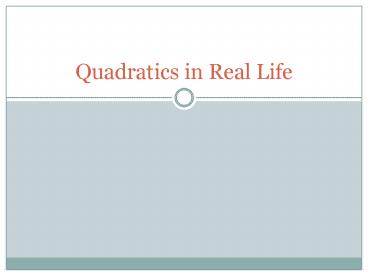Quadratics in Real Life - PowerPoint PPT Presentation
1 / 10
Title:
Quadratics in Real Life
Description:
Quadratics in Real Life Quadratic functions are more than algebraic curiosities they are widely used in science, business, and engineering. The U-shape of a ... – PowerPoint PPT presentation
Number of Views:168
Avg rating:3.0/5.0
Title: Quadratics in Real Life
1
Quadratics in Real Life
2
- Quadratic functions are more than algebraic
curiositiesthey are widely used in science,
business, and engineering. - The U-shape of a parabola can describe the
trajectories of water jets in a fountain and a
bouncing ball, or be incorporated into structures
like the parabolic reflectors that form the base
of satellite dishes and car headlights. - Quadratic functions help forecast business profit
and loss, plot the course of moving objects, and
assist in determining minimum and maximum values.
- Most of the objects we use every day, from cars
to clocks, would not exist if someone, somewhere
hadn't applied quadratic functions to their
design.
3
We commonly use quadratic equations in situations
where two things are multiplied together and they
both depend of the same variable. For example,
when working with area, if both dimensions are
written in terms of the same variable, we use a
quadratic equation. Because the quantity of a
product sold often depends on the price, we
sometimes use a quadratic equation to represent
revenue as a product of the price and the
quantity sold. Quadratic equations are also
used when gravity is involved, such as the path
of a ball or the shape of cables in a suspension
bridge.
4
Balls, Arrows, Missiles and Stones
- If you throw a ball (or shoot an arrow, fire a
missile or throw a stone) it will go up into the
air, slowing down as it goes, then come down
again ... - ... and a Quadratic Equation tells you where it
will be!
5
Example Throwing a Ball
- A ball is thrown straight up, from 3 m above the
ground, with a velocity of 14 m/s. When does it
hit the ground? - Ignoring air resistance, we can work out its
height by adding up these three things - The height starts at 3 m 3
- It travels upwards at 14 meters per second (14
m/s) 14t - Gravity pulls it down, changing its speed by
about 5 m/s per second (5 m/s2) -5t2
6
Add them up and the height h at any time t is
- h-5t2 14t 3
- And the ball will hit the ground when the height
is zero - -5t2 14t 3 0
- It will be easier to solve if we factor out the
negative 1 - -1(5t2 - 14t - 3 ) 0
- Divide both sides by -1 and we have
7
5t2 - 14t - 3 0
- 5t2 - 14t 3 (5t 1)(t 3)
- So our two solutions are
- t -0.2 and t 3
- The "t -0.2" is a negative time, impossible in
our case. - The "t 3" is the answer we want
- The ball hits the ground after 3 seconds!
8
What does it look like?
- Here is the graph of the Parabola h -5t2 14t
3
- It shows you the height of the ball vs time
- Some interesting points
- (0,3) When t0 (at the start) the ball is at 3 m
- (-0.2,0) Says that -0.2 seconds BEFORE we threw
the ball it was at ground level ... this never
happened, so our common sense says to ignore it! - (3,0) Says that at 3 seconds the ball is at
ground level. - Note also that the ball reaches nearly 13 meters
high.
9
What about that maximum?
- You can find exactly where the top point is!
- Find where (along the horizontal axis) the top
occurs using -b/2a - t -b/2a -(-14)/(2 5) 14/10 1.4 seconds
- Then find the height using that value (1.4)
- h -5t2 14t 3 -5(1.4)2 14 1.4 3
12.8 meters - So the ball reaches the highest point of 12.8
meters after 1.4 seconds.
10
Lets take a look at some more examples
- Profit































